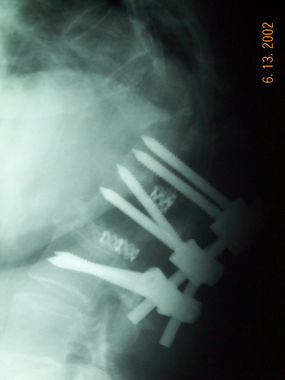
Treatments & Procedures
Dr. Law has the necessary expertise, knowledge and skills to provide comprehensive spinal care for the treatmens and procedures listed below.
He and his team of spine specialists provide patients with the latest advancements in conservative, minimally invasive care.
Listed below are the treatment and produces performed by Dr. Law. Dr. Law and his team provides the latest advancements in conservative, minimally invasive care as well as major spine surgery options. We have provided pictures, images and drawings of various treatment and procedures.
Treatments and Procedures
Minimally Invasive Spine Surgery (MISS)
Spine surgery is traditionally "open surgery." This means that the area being operated on is opened with a long incision to allow the surgeon to view and access the anatomy. In recent years, however, technological advances have allowed more back and neck conditions to be treated with minimally invasive surgical techniques.
Minimally invasive spine surgery (MISS) accomplishes the same goal as open surgery, but through smaller incisions. Common conditions treated with MISS are
-
Degenerative disc disease
-
Herniated disc
-
Lumbar spinal stenosis
-
Spinal deformities such as scoliosis
-
Spinal infections
-
Spinal instability including spondylolisthesis
-
Vertebral compression fractures
With long incisions, there is more associated muscle damage. Because the incision is smaller with minimally invasive spine surgery, it avoids significant damage to the muscles surrounding the spine. Typically, this results in less pain after surgery and a faster recovery.
* information courtesy of and copyrighted by American Academy of Orthopaedic Surgeons
Spondylolisthesis
In spondylolisthesis, the fractured pars interarticularis separates, allowing the injured vertebra to shift or slip forward on the vertebra directly below it. In children and adolescents, this slippage most often occurs during periods of rapid growth — such as an adolescent growth spurt.
Doctors commonly describe spondylolisthesis as either low grade or high grade, depending upon the amount of slippage. A high-grade slip occurs when more than 50% of the width of the fractured vertebra slips forward on the vertebra below it. Patients with high-grade slips are more likely to experience significant pain and nerve injury and to need surgery to relieve
their symptoms and prevent further deterioration
* information courtesy of and copyrighted by American Academy of Orthopaedic Surgeons
Deformity Correction (Scoliosis and Kyphosis)
Scoliosis is a sideways curve in the spine. Kyphosis is a forward curvature of the spine. In adults scoliosis and kyphosis may occur as the discs degenerate. The disc may collapse more to the front or the side causing the spine to deform.


Coccygectomy (tailbone removal)
Coccygectomy is a surgical procedure in which the coccyx or tailbone is removed. It is considered a required treatment for sacrococcygeal teratoma and other germ cell tumors arising from the coccyx. Coccygectomy is the treatment of last resort for coccydynia (coccyx pain) which has failed to respond to nonsurgical treatment. Non surgical treatments include use of seat cushions, external or internal manipulation and massage of the coccyx and the attached muscles, medications given by local injections under fluoroscopic guidance, and medications

Failed Back surgery
See images below
There can be many causes for back surgery to fail. Common causes are:
-
Inadequate nerve decompression
-
Too much decompression causing instability
-
Nerve Damage
-
Failure of fusion (pseudoarthrosis)
-
Deformity (Flatback syndrome)
-
Mechanical failure of the implant
-
Bone failure (osteoporosis)
-
Construct failure (Broken screws and rods)
-
Failure of the disc next to the fusion (Adjacent segment failure)
-
Scar tissue

Alternatives to Fusion (Artificial Disc and Dynamic Stabilization)
See images below
Disc replacement surgery involves replacing the painful disc in the spine with an artificial disc. The goal of artificial disc replacement surgery is to preserve the normal motion of the spine (unlike fusion, which eliminates motion at the painful spinal segment). Artificial disc surgery has the theoretical of preserving spinal motion and reducing the risk that other segments of the lumbar spine will wear down prematurely.

Dynamic stabilization. This treatment is different from fusion in that posterior dynamic stabilization seeks to preserve motion in the spine while also taking pressure off the diseased vertebral disc. The theory is that removing pressure from the painful disc will create a favorable healing environment and reduce pain. The devices used in the surgery are designed to unload pressure from the vertebral disc in the same way a dynamic (moveable) brace unloads pressure from an injured knee or ankle to allow it to heal
* information courtesy of and copyrighted by Spine-Health

Osteoporosis
Osteoporosis is defined as a systemic skeletal disease characterized by low mineral bone mass and microarchitectural deterioration of bone tissue, more specifically a decrease in the number of trabeculae coupled to trabecular thinning and loss of connectivity, as well as decrease in cortical thickness and an increase in its porosity. This consequently increases bone fragility and susceptibility to fracture
The clinical outcome of osteoporosis is fragility fracture(s): broken bones which occur in a setting of low-level or low-energy trauma and that would otherwise not result in a fracture, such as a fall from standing height or less
Secondary osteoporosis refers to osteoporosis caused by certain medical conditions or medications that can cause bone loss, increase fracture risk, directly or indirectly affect bone remodelling or interfere with the attainment of peak bone mass in younger individuals. Treatment of secondary osteoporosis is often more complex than treatment of primary osteoporosis, as it depends on the underlying disease.
* information courtesy of and copyrighted by International Osteoporosis Foundation

A Nashville Spine Doctor and Nashville Spine Surgeon










